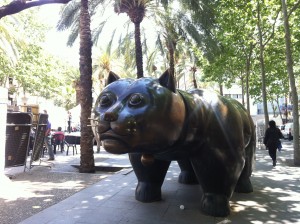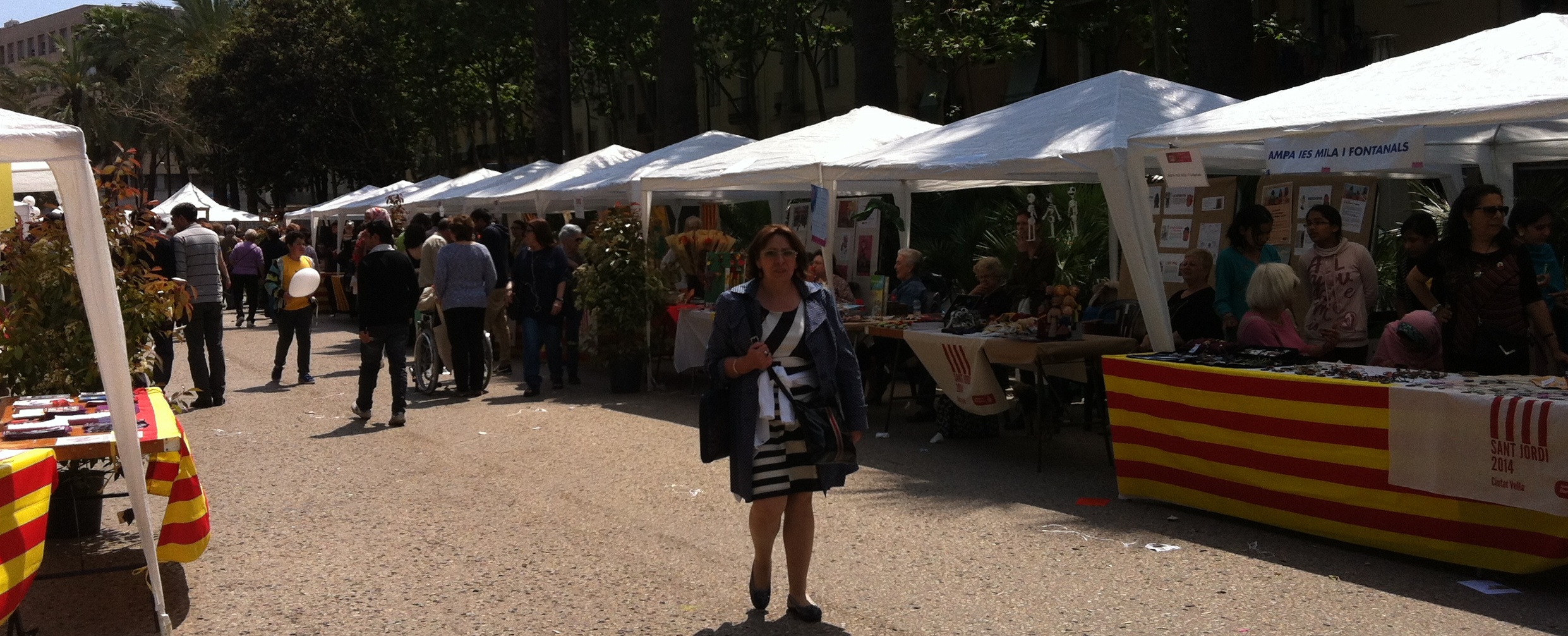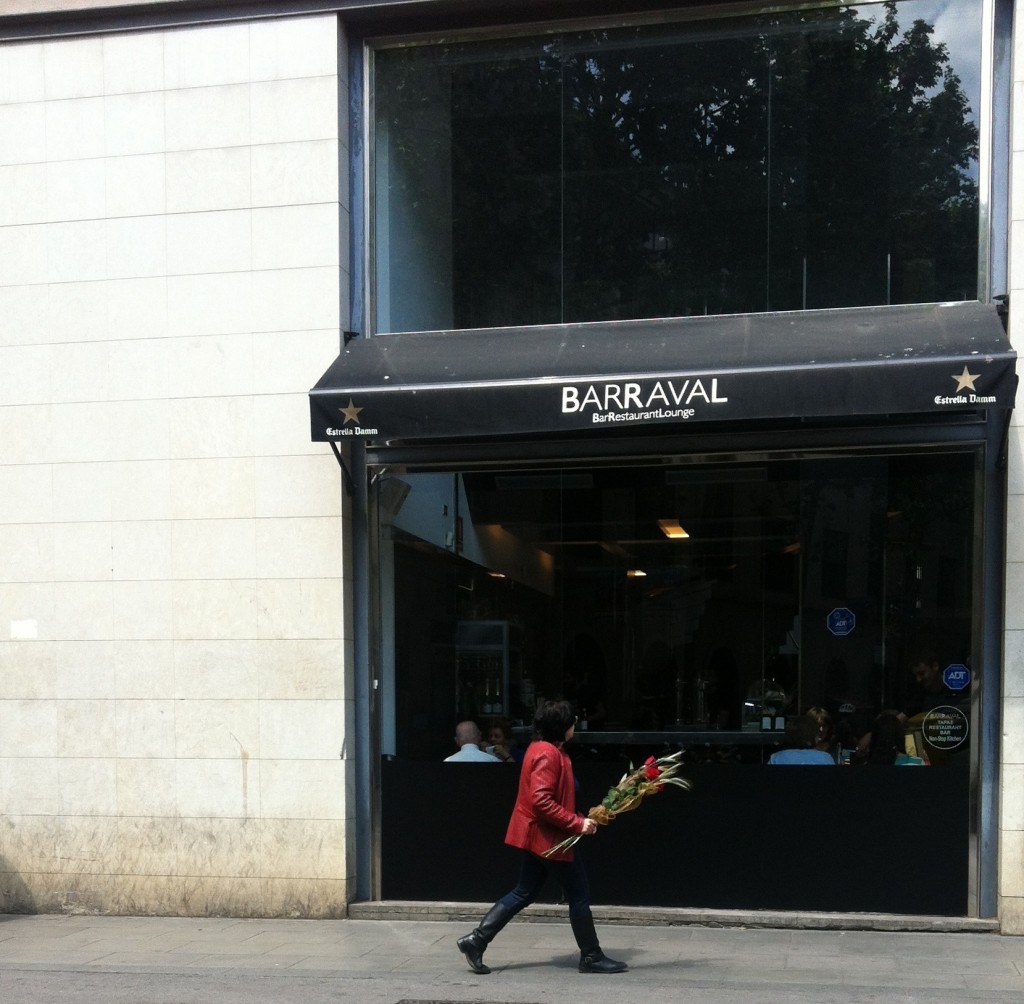Yesterday was the festival of Sant Jordi, celebrating the patron saint of Catalunya wherein people gift each other either a rose or a book. All over town, there are book stalls and flower stands set up on every corner, and in the city of Barcelona, there is a festival on the Rambla de Raval.
This long plaza is the home of one on my favorite sculptures, El Gato, by my favorite sculptor, Botero. I’ve never been able to get into the spirit of this day, probably because there already exists a Saint Valentine’s day and while the gifting of a book in theory is a good thing, I think Book Day should be more specific, like Literature day. Because useless people like Belen Esteban and Kim Kardashian have written books. But today I thought I would check out the celebration and go visit my favorite fat cat.
The street market was much like any other, with artisan soaps, jewelry and handmade clothing with lots of big buttons, panels of avocado green material and piped edges on asymmetrical dresses and shoulder bags among the book and rose sellers.
This little public area is an oblong slice surrounded by a bike lane, then a one way street, both of which loop continuously around the long center island. Shops and restaurants backdrop either side of the tree lined ovoid, with their outdoor seating on the island, requiring the waiters to navigate through first car and then bicycle traffic while balancing full trays.
I rode my bike around half of the oval, braking for a few waiters and taking in the activities. The trees today were shedding pollen like nobody’s business, catching in my throat, sneaking behind my sunglasses into my eyes, and making me stop more than once as a fit of violent sneezes took me over. I decided to walk my bike through the rest of the festival to avoid breathing in any more evil pollen than necessary. At then end of the island, I can upon the worst band I’ve ever seen in real life. They were a group of young guys on a temporary stage with a mess of plastic chairs set up in front of it. The guitarist and bassman played about a half beat behind the drummer, who was inconsistent in his rhythm and seemed to be playing too slowly for what the presumable energetic tune called for. Then another guy joined in – a horrible, off-key whine escaped from his face into the microphone. At first I thought he was playing a kazoo, but then he started moving his lips and words were formed and I realized that he was singing. I put my earphone back into my ears and walked my bike back up the other side of the island.
People everywhere carried roses in plastic with a sprig of what looked like wheat cozied alongside the long stem and peeping from the conical opening at the top. Women mostly carried them in their hands, presumably having received them as gifts, while men seemed to be transporting them – they hung out of backpacks, stuck out from bag tops and were cradled in arm crooks.
I saw far fewer books being carried, but that could be because once purchased they were put away, unlike the roses. There certainly were plenty of book stands being perused. Those who were not shopping relaxed in the outdoor seating of the restaurants, sat on benches and planter edges with plastic cups of beer, or looked around for their friends. This event would go on into the night, where presumably there would be better bands on the stage and far more people.
This day has been celebrated even before its official adoption into a constitution in the cathedral of Barcelona in 1456 declaring Sant Jordi as a festival day. Gifting roses goes back to the 15th century, though the original reason why has been lost. Books, on the other hand, were only incorporated in 1926, when Spain declared the 23rd April as Book Day (this day was chosen as it is the anniversary of the death of the Spanish writer Cervantes), which also happened to be Sant Jordi. So today we have two festivals rolled into one.
Yes, it is sweet to be recognized with a rose or a book, and I have received both on various occasions, but being a decidedly non religious person, which is the other part of the day-the celebration of a saint- I am not particularly moved by Sant Jordi. Perhaps it was because I’m not a fan of beer, or the astonishingly bad band on the stage, or the lack of an Argentinian restaurant with good empanadas nearby (I was craving them) – whatever the case, I decided that I had seen enough.
I said goodbye to the fat cat and took my leave, sneezing.











